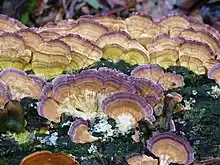Trichaptum biforme
Trichaptum biforme is a species of poroid fungus in the order Hymenochaetales. It is a saprobe that decomposes hardwood stumps and logs. Colloquially known as Purple Tooth or Violet Toothed Polypore. It has a violet colored edge that fades with age. It is inedible.[2][3] It is widely distributed and occurs on at least 65 tree hosts, but rarely on conifers. It is sometimes confused with Trichaptum abietinum, which grows almost exclusively on conifers.[3]
| Trichaptum biforme | |
|---|---|
 | |
| Scientific classification | |
| Kingdom: | |
| Division: | |
| Class: | |
| Order: | |
| Family: | |
| Genus: | |
| Species: | T. biforme |
| Binomial name | |
| Trichaptum biforme | |
| Synonyms | |
| |
References
- Ryvarden, L. (1972). "A critical checklist of the Polyporaceae in tropical East Africa". Norwegian Journal of Botany. 19: 229–238.
- Phillips, Roger (2010). Mushrooms and Other Fungi of North America. Buffalo, NY: Firefly Books. p. 315. ISBN 978-1-55407-651-2.
- Lincoff, Gary (1981). National Audubon Society Field Guide to North American Mushrooms. Alfred A. Knopf. p. 490. ISBN 978-0-394-51992-0.
| Trichaptum biforme | |
|---|---|
| Teeth on hymenium | |
| Cap is flat | |
| Hymenium attachment is not applicable | |
| Lacks a stipe | |
| Spore print is white | |
| Ecology is saprotrophic | |
| Edibility is inedible | |
This article is issued from Wikipedia. The text is licensed under Creative Commons - Attribution - Sharealike. Additional terms may apply for the media files.